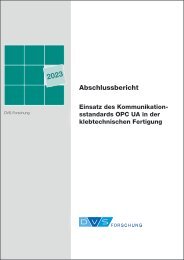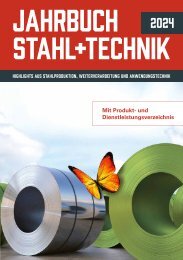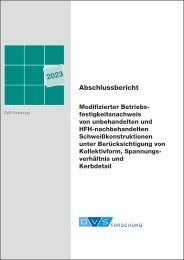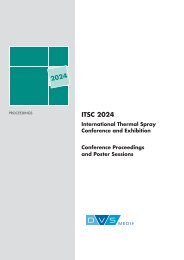STEEL + TECHNOLOGY 01/2020 EXTRACT
STEEL + TECHNOLOGY 01/2020 EXTRACT
STEEL + TECHNOLOGY 01/2020 EXTRACT
You also want an ePaper? Increase the reach of your titles
YUMPU automatically turns print PDFs into web optimized ePapers that Google loves.
<strong>STEEL</strong> <strong>TECHNOLOGY</strong> | 41<br />
Table 2. Semiquantitative chemical analyses via EDX (wt.-% rounded))<br />
0 1 2 3<br />
MgO 10% 11% 4% --<br />
Al 2 O 3 13% 14% 16% --<br />
SiO 2 -- -- 66% --<br />
TiO 2 1% 2% 1% --<br />
Cr 2 O 3 44% 59% 10% --<br />
Fe x O y 32% 14% 3% --<br />
Remark<br />
Chromite from<br />
the ladle well<br />
filler<br />
Boundary of<br />
chromite grain<br />
with reduced<br />
Fe x O y content<br />
Siliceous<br />
phase containing<br />
oxides<br />
from the ladle<br />
well filler<br />
Table 3. Semiquantitative chemical analyses via EDX (wt.-% rounded)<br />
Steel 1 after<br />
crucible test<br />
96 wt.-% Fe,<br />
4 wt.-% Cr<br />
Figure 8. Crucible test 2 with conventional<br />
ladle well filler and Steel 2 (Picture:<br />
Purmetall)<br />
0 1 2<br />
MgO -- 9% --<br />
Al 2 O 3 >99% 67% --<br />
SiO 2 -- -- --<br />
TiO 2 -- -- --<br />
Cr 2 O 3 -- 3% --<br />
MnO -- 21% --<br />
Fe x O y -- -- --<br />
Remark Alumina crucible MnO-rich phase<br />
including oxides<br />
from the ladle well<br />
filler (Mg,Mn)O<br />
(Al,Cr) 2 O 3<br />
Steel 2 after crucible<br />
test<br />
85 At.-% Fe, 10<br />
At.-% Cr, 3 At.-%<br />
Mn, 1 At.-% Si<br />
Table 4. Semiquantitative chemical analyses via EDX (wt.-% rounded)<br />
0 1 2<br />
MgO -- 3% --<br />
Al 2 O 3 -- 37% --<br />
SiO 2 -- 57% --<br />
TiO 2 -- -- --<br />
Cr 2 O 3 -- -- --<br />
MnO -- -- --<br />
Fe x O y -- -- --<br />
Remark<br />
Steel 2 after crucible<br />
test<br />
78.8 At.-% Fe,<br />
16.5 At.-% Mn,<br />
2.5 At.-% Si,<br />
2.3 At.-% Al<br />
ventional ladle well filler and steel 1 of crucible-test<br />
1.<br />
Conventional ladle well filler consists in its<br />
initial state of chrome ore and silica sand.<br />
Siliceaous phase<br />
3 wt.-%<br />
Na 2 O<br />
Manganese steel<br />
78.8 wt.-% Fe,<br />
16.5 wt.-% Mn,<br />
2.5 wt.-% Si,<br />
2.3 wt.-% Al<br />
After the thermal treatment at 1,600°C the<br />
conventional ladle well filler forms a dense<br />
texture of dense chrome ore particles (light<br />
grey) and a secondary phase which is of low<br />
Figure 9. Crucible test 3 - new type of<br />
ladle well filler and Steel 2 (Picture:<br />
Purmetall)<br />
viscosity at 1,600°C (dark grey). The outer rim<br />
of the chrome ore particles are reduced in<br />
their Fe x O y amount. The secondary formed<br />
phase consists of SiO 2 from the silica sand<br />
and the oxides of the chrome ore. This means<br />
a diffusion of the oxides MgO, Al 2 O 3 , Cr 2 O 3<br />
and Fe x O y from the chrome ore to the siliceous<br />
secondary phase took place.<br />
Additionally, redox reactions between the<br />
conventional ladle well filler and the ball bearing<br />
steel take place. Small amounts of manganese<br />
and silicon from the steel diffuse into<br />
the ladle well filler and get oxidized (MnO- and<br />
SiO 2 -pickup into the ladle well filler). On the<br />
other hand, Cr 2 O 3 of the ladle well filler diffuses<br />
into the steel and is reduced to metallic<br />
chrome (Cr-pickup into the steel).<br />
In comparison figure 11 shows a SEM<br />
picture of the texture formed at the contact<br />
area of conventional ladle well filler<br />
<strong>STEEL</strong> + <strong>TECHNOLOGY</strong> 2 (<strong>2020</strong>) No. 1


















